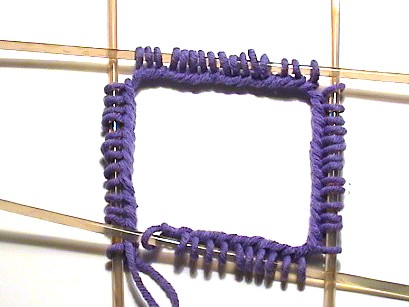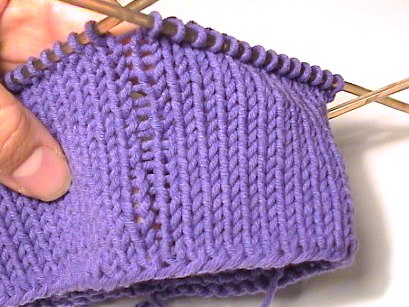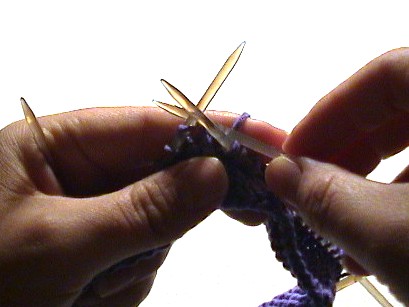Double-pointed needles...friend
or foe?
...the knitting basket...was
well equipped, with three long circular wire
needles in different sizes, and a sinister-looking
set of four double-ended ivory ones, slender
as stillettos, which I knew were used in some
mysterious fashion to turn the heels of stockings.
-- Diana Gabaldon, Drums of Autumn
If you've ever felt a tremble
of fear at the thought of using double-pointed
needles, read on...
Double-pointed needles come
in various lengths, from tiny little 4 inchers
used to knit the fingers of gloves, up to
a whopping 16-inch-long needes for Shetland
lace. They're available in all sorts of materials,
from warm birch to flexible casein and bamboo
and from elegant ebony to super-strong steel.
The ones I find most comfortable to knit with
are around 8 inches long. The needles come
in sets of 4 or 5, but it makes sense to buy
sets of 5 whenever you have a choice. Dividing
your work over 4 needles rather than 3 helps
keeps tension from distorting the stitches
[more on this later] and you won't have to
run out for an extra set if you drop one and
it rolls between the boards and under the
front porch.
Double-pointed
needles are used to knit in the round when
there are too few stitches to fit comfortably
around on a set of circulars; socks, mittens
and the crowns of caps are common places to
employ them. To cast on with double points,
you can cast on all stitches on one needle,
then slip an even number of stitches to the
other 2 or 3 needles, or cast on to each needle in turn. Once the required
number of stitches are divided evenly over
the needles, be sure they're not twisted by
laying the needles flat and arranging the
stitches so the bottom of the cast on row
is facing the inwards as shown below:

Join and begin to knit by
inserting the remaining empty needle into
the stitch that was cast on first. Until you
become accustomed to knitting with double
points, it may feel like you've got an unruly
hedgehog in your hands. It's frustrating but
not terribly uncommon for the needles to slip
out of the stitches on the first few rounds
or if there are very few stitches on each
needle. If you're just beginning with double
points, choose lightweight plastic or wooden
needles and a non-slippery yarn. Metal needles
and cotton yarn can wait until you've got
a bit more experience under your belt.
How you hold the needles
is purely a matter of personal choice. Just
keep
your attention focused on the two needles
that you're working with at any
given time - no different than any other type
of knitting! - and let the
other needles hang loosely inside the circle
of your fingers, supporting
them in any way it feels comfortable. You
may want to center the stitches on
a needle before moving to the next needle.
It helps prevent stitches
accidentally dropping off.

Begin by knitting over the
stitches on the first needle. When it is empty,
transfer it to your working hand and begin
to work over the stitches on the second needle.
Do the same for the rest of the needles and
you'll be fast friends in no time.
The dreaded ladder:

Looseness at the point where
you change from one needle to the next can
lead to a ladder forming from the yarn being
stretched in the space between two distorted
stitches. Fortunately, there are several ways
to avoid them.
- The best way: Make it a habit
to tighten things up when moving from one
needle to the next by giving the yarn a tug
after working the first and second stitches.
It's become such second nature to me that
I had to work very hard to make the ladder
for the picture above!
- Using a set of 5 needles
rather than 4 will divide tension more evenly,
keeping strain off of the stitches themselves.
- If you're still having
trouble, knitting a couple of stitches forward
from the next needle onto the one you've just
finished with will shift the point of tension,
thus helping to keep a vertical line from
forming.
- Inserting
the working needle under the previous needle
as shown below will help you make a tighter
stitch than if you come at it from above.

One final note:
I realize that there are many, many people
who say
"Pish-posh - there's no need to use double
points when you can use two
circulars," but I think I'm going to
try to avoid getting into that particular
conversation if you don't mind.

